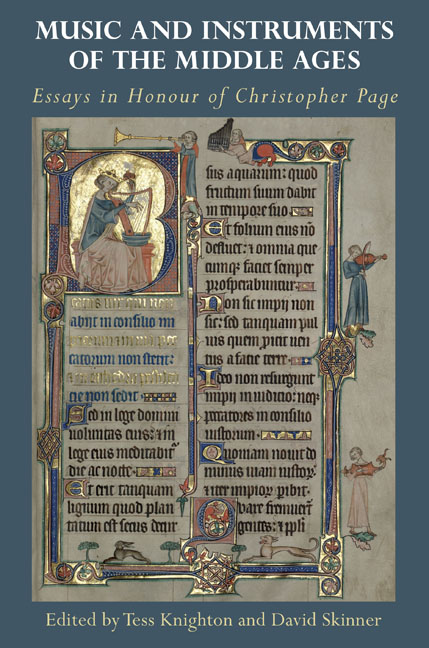Book contents
- Frontmatter
- Contents
- List of Illustrations
- List of Music Examples
- List of Tables
- List of Contributors
- List of Music Manuscript Sigla
- Acknowledgements
- Introduction
- SONGSTERS AND THEIR REPERTORIES
- CLOSE READINGS
- CREATING POLYPHONY
- MUSIC AS CULTURAL PRACTICE
- Works Cited
- Works by Christopher Page
- Index
- Tabula Gratulatoria
- Studies in Medieval and Renaissance Music
15 - Non-Mensural Polyphony: Performing Plainsong
Published online by Cambridge University Press: 24 November 2020
- Frontmatter
- Contents
- List of Illustrations
- List of Music Examples
- List of Tables
- List of Contributors
- List of Music Manuscript Sigla
- Acknowledgements
- Introduction
- SONGSTERS AND THEIR REPERTORIES
- CLOSE READINGS
- CREATING POLYPHONY
- MUSIC AS CULTURAL PRACTICE
- Works Cited
- Works by Christopher Page
- Index
- Tabula Gratulatoria
- Studies in Medieval and Renaissance Music
Summary
A MISPLACED TRADITION?
Something that has been ‘misplaced’ has been either put in the wrong place or lost altogether (for example, because it had been misplaced). This may have happened to a tradition of early music which we will call ‘non-mensural polyphony’. To start with, it cannot easily be found because it goes by many names. Researchers variously call it ‘simple’, ‘primitive’, ‘archaic’, ‘peripheral’, ‘organum-like’ (‘organal’), ‘early’, ‘liturgical’, ‘usual’ (‘usuell’), ‘monastic’ (‘klösterlich’), ‘oral’ and ‘retrospective’ polyphony. You may be forgiven for thinking that a musical tradition with so many names would command the particular affection of music historians – but no. The plurality of the nomenclature only suggests that they did not really know where to place it. Understandably, leading reference works and general music histories make no mention of it. But the misplacement is not entirely accidental; it corresponds to a misconception in the historiography of early European music.
‘Medieval music’ is conceived as a dual tradition: monophonic and polyphonic. Monophony comprises liturgical plainsong and – more marginally – vernacular artsong; polyphony begins with early organum and arrives, via ‘Notre-Dame’ and ‘ars nova’, at Renaissance counterpoint and the music of our time. ‘Simple’ polyphony is understood – when mentioned at all – as a minor or more conservative variant of polyphony, which has failed to reach Renaissance counterpoint and thus our time; it lacks both the progressive trajectory of counterpoint and the ritual dignity of monodic plainsong. Under these historiographical preconceptions, it is no surprise when certain traditions of music-making disappear from standard history-writing. ‘Simple’ polyphony is in fact not the only species threatened by musicological extinction: Latin song in its diverse non-liturgical traditions and early instrumental practices are usually discussed in music histories only as far as they were notated and polyphonic.
Archival, theoretical and literary sources of the era, however, do not always distinguish between monophony and polyphony. Neither of these terms was actually used at the time. The contemporary terms ‘diaphonia’, ‘organum’ and ‘discantus’ (with their variations) were more special names that never embraced all the possible techniques we would call ‘polyphony’. It remained ‘plain’ even with embellishments or enhancements. It became multiple, for example, when doubled at the fifth and octave.
- Type
- Chapter
- Information
- Music and Instruments of the Middle AgesEssays in Honour of Christopher Page, pp. 373 - 384Publisher: Boydell & BrewerPrint publication year: 2020



